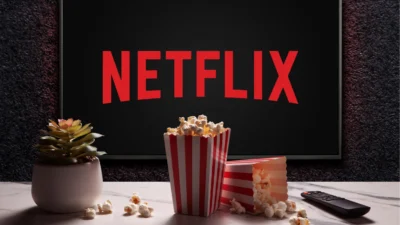In the late 1990s, renting a movie meant driving to a video store, picking a DVD, and hoping you returned it before the due date. It was routine, but frustrating. That’s when Reed Hastings, a software engineer in California, was hit with a forty-dollar late fee for a delayed VHS rental. That small incident sparked a big question in his mind: what if watching movies could be simpler?
From that question began the journey of Netflix. What started as a DVD rental service eventually transformed global entertainment. The story of Netflix is not just a business case study. It’s a real-world example of bold decisions, listening to customers, using technology wisely, and constantly adapting to change.
Starting Small with a Big Idea
Netflix was launched in 1997. It allowed people to order DVDs online and have them delivered to their homes. Once finished, customers could send the DVDs back through the mail. There were no late fees. This simple improvement made Netflix an attractive alternative to traditional video stores.
Soon, Netflix introduced a monthly subscription model. Customers could now watch as many movies as they wanted without worrying about deadlines. It was this customer-focused mindset that set the foundation for everything Netflix would later become.
The company was not just offering DVDs. It was offering freedom, flexibility, and convenience at a time when those ideas were rare in entertainment.
A Turning Point that Changed Everything
As Netflix gained traction, it approached Blockbuster, the dominant video rental chain, with a proposal to sell itself for 50 million dollars. Blockbuster rejected the offer, confident in its existing model. What it missed was that Netflix was not just another DVD company. It was a technology-first business that saw where the future was headed.
Netflix understood that internet speeds were improving and that waiting days for a DVD would soon feel outdated. In 2007, Netflix launched its streaming service, allowing users to watch movies and shows directly on their devices. The collection was limited at first, and the quality wasn’t perfect, but the direction was clear. People liked the idea of watching instantly.
By being early to adopt streaming, Netflix gained valuable learning time. It built stronger technology, created smarter recommendation engines, and began collecting user data that would later become the heart of its content strategy.
Changing the Way We Watch
In 2013, Netflix took another leap. It produced its first original series, House of Cards. But the bigger surprise came when the company released all the episodes at once. This move went against decades of traditional TV scheduling. But it worked.
Audiences loved the control. They could watch one episode or the entire season in a weekend. Netflix trusted viewers to set their own pace, and this gave birth to a new culture of binge-watching.
Over the next few years, Netflix expanded its original content lineup. Shows like Narcos, Stranger Things, The Crown, and Money Heist weren’t just popular in one country. They became global sensations.
What Netflix proved was that good storytelling didn’t need to be local to be relatable. Subtitles and dubbing made global content accessible. People in India began watching Spanish thrillers. Viewers in the US started enjoying Korean dramas. Netflix had erased borders with stories.
How Netflix Used Data to Shape Decisions
Behind every recommendation you see on Netflix is a smart use of data. The platform watches what you watch, when you pause, how long you stay on a show, and when you exit. This helps it personalize your experience and recommend the next best thing.
But it goes deeper than that. Netflix doesn’t just use data to guide viewers. It uses it to decide what content to create. If users in Brazil enjoy romantic dramas more than action films, Netflix invests in more local romantic stories. If Indian viewers love documentaries, the company adds more of them to the mix.
This approach makes content creation smarter and more targeted. Traditional studios relied heavily on instincts and past hits. Netflix used patterns in user behavior to guide future investments.
Expanding Across the Globe
After achieving success in the US, Netflix began expanding internationally. It didn’t just launch with dubbed Hollywood films. It began producing local content for each market. In India, shows like Sacred Games and Delhi Crime became big hits. In South Korea, the company backed projects like Kingdom and later Squid Game, which went on to become one of the most-watched series worldwide.
By giving local creators a platform and offering global distribution, Netflix made itself relevant in every market. This strategy not only grew its subscriber base but also gave birth to a new wave of global storytelling.
Where earlier shows were limited to local audiences, Netflix gave them an international stage. This changed the dynamics of the entertainment industry and gave smaller markets the opportunity to shine.
Facing Competition and Market Challenges
Netflix was not going to remain unchallenged for long. As streaming became more mainstream, many companies entered the market. Disney launched Disney+, Amazon strengthened Prime Video, and HBO, Apple, and others brought their platforms into the game.
Each platform came with its own content library, pricing model, and fanbase. Netflix, which once had a monopoly, now had to compete harder for people’s time and money.
Another challenge was pricing. In markets like India, Netflix was seen as premium. Competitors offered similar content at much lower prices. To address this, Netflix introduced mobile-only plans and region-specific offers.
But perhaps the most important signal came in 2022. For the first time in more than a decade, Netflix lost subscribers. Growth had slowed. Content budgets had ballooned. Some originals didn’t perform. The industry took notice.
It was a reminder that even the biggest names must keep proving their value.
A New Chapter with New Revenue Models
To respond, Netflix made a few bold moves. One of the most unexpected was introducing a lower-priced plan that included advertisements. For years, Netflix had promised an ad-free experience. But changing business realities called for a more flexible approach.
This allowed Netflix to serve users who didn’t mind occasional ads and wanted cheaper subscriptions. It also opened up a new revenue stream through advertisers.
Netflix also started exploring the gaming space. It launched mobile games based on its shows and began testing interactive formats. These new areas are part of its broader plan to keep viewers engaged and create deeper brand loyalty.
What Businesses Can Learn from Netflix
The Netflix journey is not just a tale of tech and entertainment. It holds lessons for anyone building a business today.
One key takeaway is the importance of timing. Netflix introduced streaming before people were fully ready, giving it a long runway to improve. It didn’t wait for the market to demand a change. It led the change.
Another important lesson is adaptability. Netflix has reinvented itself multiple times. From DVD rentals to streaming, from content distributor to content creator, and now to advertising and gaming. Businesses that remain rigid in a fast-changing world often get left behind.
A third lesson is the value of listening to users. Netflix paid close attention to what its users watched, liked, and skipped. That feedback loop helped it stay relevant and make smarter content investments.
Finally, Netflix shows that bold risks are necessary for long-term leadership. Launching original content, releasing all episodes at once, expanding globally with local stories, and adding ads after years of resisting them — these weren’t easy choices. But they were necessary for survival and growth.
Conclusion
Netflix started with a simple pain point — avoiding a late fee. From there, it grew into one of the most influential entertainment companies in the world. It disrupted an entire industry, created new habits, and proved that storytelling has no boundaries.
Today, when you click “Next Episode,” it might feel like a small action. But behind it is a story of vision, risk, reinvention, and relentless customer focus.
For entrepreneurs, marketers, or even everyday readers, Netflix’s journey is a reminder that sometimes the biggest opportunities start from the smallest frustrations. What matters is how you respond, how you evolve, and how committed you are to staying relevant in a world that changes every day.






